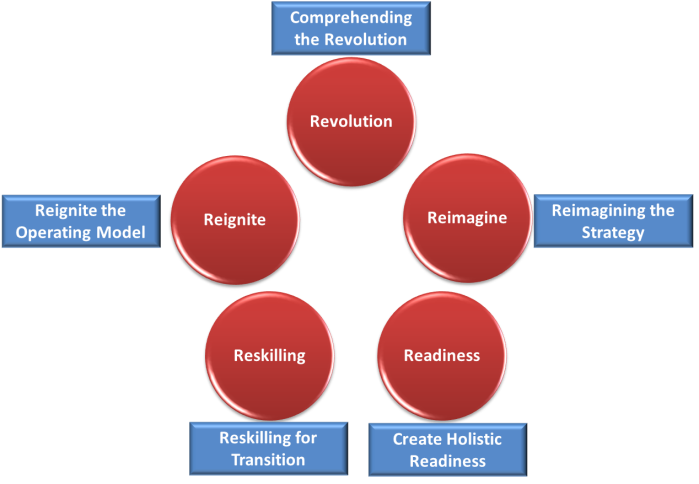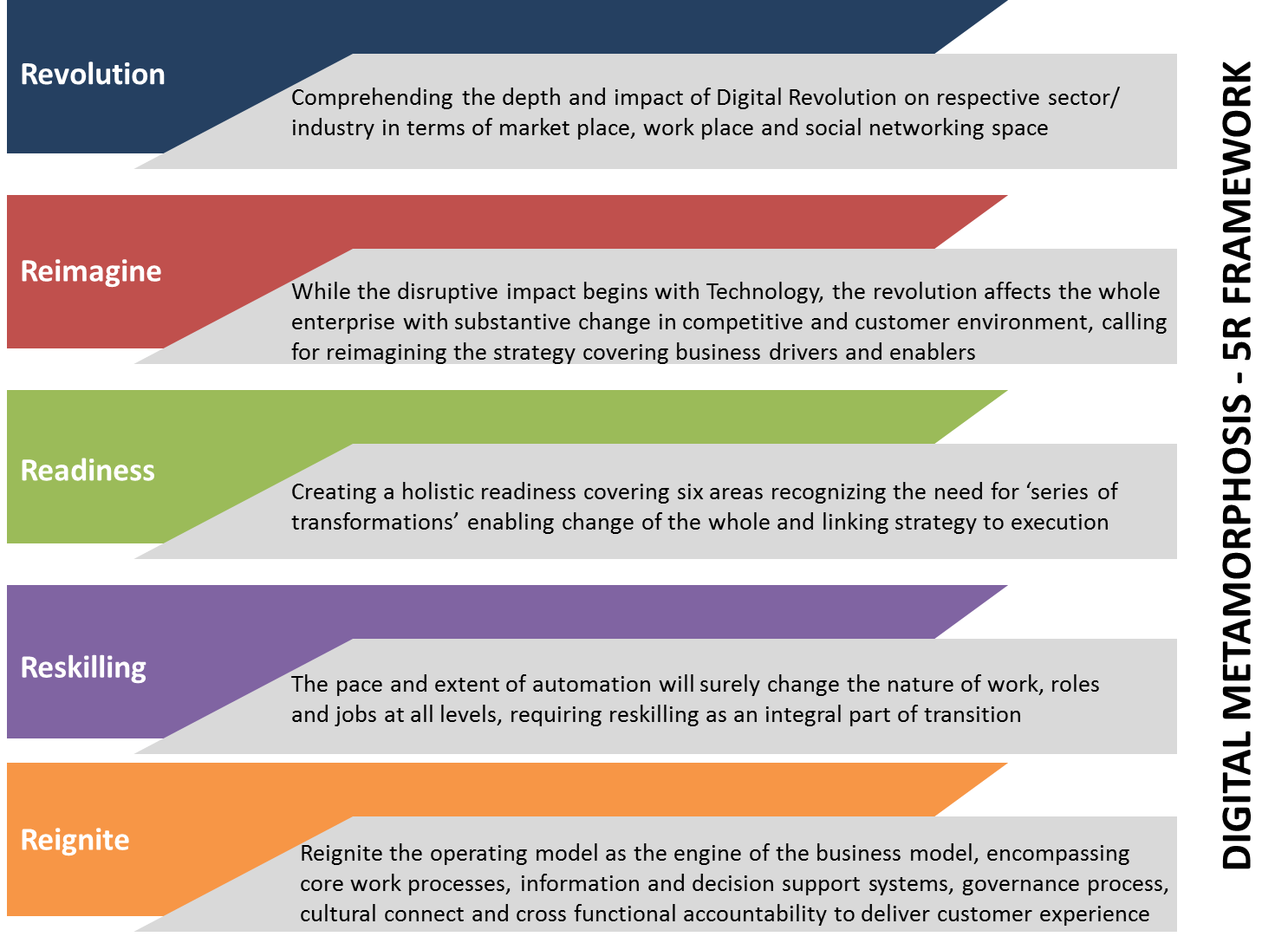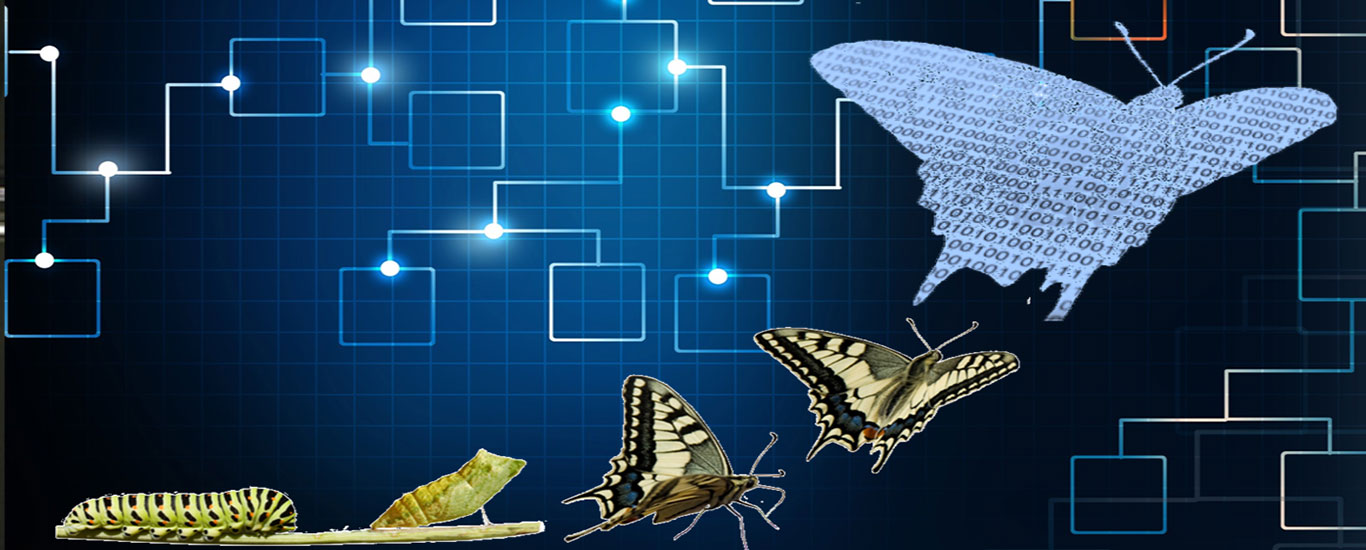
Would you like to start a conversation with other industry leaders to brainstorm a challenge or to just know more on a particular topic?
Engage in online discussions with your Peers
Start Now "A new economic paradigm is emerging, with a new structure, behaviour, institutions and values. A more precise label would be Economic Metamorphosis."
— Milan Zeleny
The Business Services Technology organizations in Global India are at an ‘inflection point’ of a significant growth opportunity as digital technologies replace the traditional technologies. Decades back, when the technology automation happened in the manufacturing industry for the core production environment and blue collar roles, China took the best advantage in the global arena to reap the benefits. Now, when the digital disruption in the manufacturing/ services/ non-production sectors and the knowledge worker roles is taking place, India is clearly poised to capture this huge opportunity to be the major beneficiary of the emerging Digital Economy.
The global and domestic market presents a huge opportunity for Global India organizations that can build expertise in these new technologies and deliver value through them.
…the digital revolution will comprehensively affect market place, work place, and social networking space…current jobs and roles, rewrite competition, change the way customers access and demand fulfilment of services…
As per the Nasscom Perspective 2025 Report, “the Indian technology and services industry is on track to reach its goal of $200 billion to $225 billion in revenues by 2020 and furthermore, to reach revenues of $350 billion by 2025”. India clearly has an edge to become a global centre for innovation in digital technology if the government, industry, Nasscom and academia can work together to create the right conditions for the technology and services industry to sustain its momentum.
Keeping things simple is the most essential requirement in this complex digital environment that is dramatically reshaping the global economy. Currently, most world economies including developed ones like USA and UK are undergoing ‘fundamental transformations’ of economic sectors. As one of the American Economists, Milan Zeleny, presently the Professor of Management Systems, Fordham University New York, has articulated, “this ‘new transformation’ is different from all preceding economic transformation of sectors. …The emerging economic paradigm can be more precisely labelled as ‘Metamorphosis’ i.e. the outcome of series of transformations, not dissimilar to a caterpillar-to-butterfly change of form…” In many ways, the depth and extent of impact on companies due to the digital environment is comparable to the above new economic paradigm, demanding ‘series of transformations’ to transition, and hence, is best termed as ‘Digital Metamorphosis’.
The real focus is to go beyond the ‘whys’ and capture ‘how’ organizations need to prepare themselves for the digital metamorphosis i.e. to assess and transition carefully into this digital world according to their organizational requirements.This can be achieved through a 5R approach as the agenda for action – Comprehending the Revolution, Reimagining the Strategy, Creating Holistic Readiness, Reskilling for Transition, and Reigniting the Operating Model.

Comprehending the Revolution
Over the next 5 to 10 years, the industry has well recognized that the Digital Age will spin a potent combination of five digital forces – Mobility, Big Data, Social Media, Cloud, and AI-Robotics – to create an unprecedented revolution. These five disruptive forces will shake and rewrite the global economy, touch every aspect of society and create a world that is more interconnected across networks, more interactive across stakeholders, and more aware across proprietary big data to new public sources of open data.
There are several interpretations that exist to capture what leaders call ‘Digital’. It varies from, ‘synonymous with IT’ or ‘focused on Customer-facing technology activities’ or ‘limited to Technology investments in all parts of business’ or ‘Technology innovation related activities’ or merely ‘restricted to Data and analytics activities’. Each of these is far from the reality that is happening around us and the future that will overtake our imagination in the next few years.
The impact is so wide and deep, it often goes much beyond one’s capability to even comprehend! Simply put, this becomes a revolution, as the digital revolution will comprehensively affect market place, work place, and social networking space. It will affect current jobs and roles, will rewrite competition, will change the way customers access and demand fulfilment of services, and will truly make the globe borderless to link suppliers and customers, and so on.
With unprecedented advances in Internet of Things, Robotics, Artificial Intelligence and related innovations, machines match or outperform human performance in a range of work activities including those requiring cognitive capabilities.
This global phenomenon will have far reaching internal and external implications to businesses and industries across geographies and sectors. The pace of organizations in the digital environment will vary and will demand organisations to operate in a way to cater to customers entering this new, high velocity environment at different speeds.
While political observers may tend to remark that ‘protectionism’ is surfacing in advanced economies like USA and UK, it is more of a ‘relocalization’ that seems to be happening as part of Economic Metamorphosis, after the localization and globalization stages of the global economy, as Milan Zeleny succinctly puts it. The Digital Revolution is very much part of this new seemingly paradoxical economic order of reality evolving across the world.
The thin line between process and technology will blur and Business Services professionals will need to be skilled to work with digital processes that will need combining IT, process knowledge and business acumen.
Reimagining the Strategy
The powerful ‘strategic triangle’ framework of Three Cs model – Customer, Competition, Corporation – shared by Kenichi Ohmae continues to provide the best starting point for the digital age as well. While the Digital Age is triggered by the five forces of technologies as outlined earlier, the revolution clearly confirms that it is not just about technology. The digital tools and technologies have invaded the total business environment with substantial change in the way we work, communicate and sell. The digital revolution cross connects 3 enabling dimensions – People, Process, Technology – with three 3 critical drivers– Customer, Business and Control. The disruptive impact is that the Two Cs – Customer and Competition – are heading for sea change and hence, the third C – the Corporation – needs to totally ‘reimagine’ its strategy to covering all aspects of business, while creating its transition road map. This is not just a transformation of technology.
Every organization is likely to tread a different path in its digital metamorphosis journey depending on its starting point and the digital maturity of its industry and products or services. Obviously, the Hi Tech, Media & Entertainment and Retail, followed by Travel & Logistics, Telecom and Financial Services, have deeper penetration of digital environment across their business and hence, have been required to come up with their ‘reimagining’ strategy for the digital age.
The economic landscape is expected to evolve into three types of enterprises: Digital Leaders & Attackers, Smart Followers and Digital Laggards.
The best way to begin is with the new digital customer experience. This requires that companies think “outside-in” about their customers, markets and segments. Instead of thinking about finding customers for their products and solutions, the company now needs to think about finding products and solutions for their customers. They need to understand what activities customers perform as they evaluate, buy, and use their products, solutions and services. They need to think deeply about when and where they hand-off products, services, and information to their customers. They need to ask which activities they can perform better than customers.
Conversely, they need to ask what activities customers can perform better than the enterprise.
When it comes to competition, the digital business environment often lowers entry barriers, causing long-established boundaries between sectors to tumble. Companies have to consider this while creating their business strategy as part of their metamorphosis plan. As the McKinsey research points out, there are several trends that are redefining competition: Near-perfect price and service transparency enable customers to switch among digital retailers; Web-based service providers can lower or undermine entry barriers; Network effects reduce transaction and labour costs from aggregated data; Plug & play business models disaggregate value chains; Borderless digital world converges global supply and demand etc.
In order to transition successfully, companies need to focus on reimagining their strategy and business model around 6 key anchors:
- Marketing & Distribution
- Products & Services
- Business Processes & Systems
- People & Talent
- Ecosystem
- Supply Chains
As can be observed, Systems is just one part of the six anchors and it reinforces that the strategy is much beyond technologies. Also, the above six anchors are interconnected and cannot be dealt with in isolation. For instance, one company enhanced its interactions among customers, suppliers, stakeholders and employees to redraw its response to transition to the digital age. Similarly, Business Services providers will find that the revenues will ‘decouple’ from headcount based pricing and new pricing models will evolve beyond even outcome based or pay-for-use to technology based service models that sustain digital client and customer experience.
Some of the challenges to be addressed are:
- Responding to change in customer behavior, managing customer sensitivities and logging into the social media and web capabilities
- Avoiding organizational and technical silos, and adopting a holistic approach
- Carefully managing information overflow, through analytics and actionable intelligence
- Bridging organizational and cultural gap for execution, with talent renewal and engagement
Creating Holistic Readiness is the step which links the Reimagining Strategy to Execution, through new operating models.
Creating Holistic Readiness
Readiness Assessment has been a prerequisite for all transformational initiatives. This enables dual purposes: validating the Strategy and preparing the Road Map for Execution. Transitioning to the new digital world, as stated earlier, is in fact ‘a series of transformations’. However, there are several instances of enterprises responding through multiple, separate, and uncoordinated initiatives, based on ‘readiness’ of that part of the enterprise. Enterprise-wide, well-orchestrated process of execution will call for what we call Holistic Readiness.
Metamorphosis, by design, clearly emphasizes ‘change of the whole’ and not transforming a part of the whole. Hence, the need for Readiness Assessment for Digital Metamorphosis needs to consider not only across all component parts of the business but also the sum of its parts as a holistic step for the enterprise to make the transition successful. Broadly, there are six areas that holistically require attention and action: 1. Customer Segments & Access, 2. Products & Services, 3. Channels of Distribution and Access, 4. Business Processes & Systems, 5. Business & Operating Models, and 6. People & Workplaces.
They cannot be dealt with individually but collectively to reap the desired benefits from this transition.
Organizations need to focus on the holistic readiness as there will be a need to execute ‘series of transformations’ with implications of ‘construction, destruction and reconstruction’ for successfully transitioning under the Digital Metamorphosis, in the right sequence. There cannot be a universal recipe on sequencing these levers because many variables are involved, such as an organization’s legacy state and the existing interconnections between customer-facing and internal processes.
However, the best results come when the transformation levers can build on each other. That means, in practice, figuring out which one depends on the successful implementation of another.
Readiness Assessment needs to cover the following 10 key elements:
- Identify Disruptive Digital themes for the industry and its changing impact on the market landscape
- Evaluate new Digital Opportunities & Threats across the five forces and not each force individually
- Assess the digital maturity of the enterprise and the investments required to go up the maturity curve
- Capture and shape market opportunities to be ahead of the competition and to speed up growth
- Review areas to develop new business models to refresh the upgraded value chain and value proposition of the enterprise
- Link the digital initiatives to Risk and Cyber Security for stakeholders and business
- People & Leadership change and impact management requirements including cultural needs
- Reskilling needs of the workforce due to digital automation and customer experience expectations
- Regulatory and compliance related requirements including finance, legal and tax
- List the suite of ‘transformational initiatives’ required to drive the digital leadership and chalk out the path of gaining ownership to drive these within the enterprise
This Digital Readiness Assessment findings will:
- Explore differing views by business functions or see how other business leaders see their own digital readiness
- Enable benchmarking the organization by sector, geography or business size, against competitors in the same sector – and against digital leaders in other sectors whose path the company would like to emulate
- Engage and drive consensus among business leaders around the corporate digital strategic execution
Creating Holistic Readiness is the step which links the Reimagining Strategy to Execution, through new operating models. Organizations should mitigate the risk of ‘digital disconnection’ and seize the opportunity to determine the business case in terms of taking action for Digital Metamorphosis.
Reskilling for Transition
As per the recent research report published by McKinsey, although digital revolution is a global phenomenon, four economies – China, India, Japan, and the United States – account for just over half of the total wages and almost two-thirds the number of employees associated with activities that are technically automatable by adapting currently demonstrated technologies. The pace and extent of automation, and thus its impact on workers, will vary across different activities, occupations and wage & skill levels. Activities that are likely to be automated sooner include predictable physical activities as well as collecting and processing data, which are activities that exist across the entire spectrum of sectors, skills and wages.
There is enough debate about automation leading to the potential for mass unemployment. Interestingly, the McKinsey research highlights that “the world’s economy will actually need every erg of human labour working, in addition to the robots, to overcome demographic aging trends in both developed and developing economies. However, the nature of work will surely change. As processes are transformed by the automation of individual activities, people will perform activities that are complementary to the work that machines do (and vice versa). These shifts will change the organization of companies, the structure and bases of competition of industries, and business models.”
Reskilling for Transition, by design, includes Change Management. While change management is an essential ingredient to the ‘series of transformations’, under Digital Metamorphosis it is much more than change – it is in fact growth.
Hence, Reskilling is an integral part of making the transition successful. The new skills that will be required will have a few pointers:
- The lack of advanced technical skills in mobile, analytics and social media isn’t the only challenge that companies face. They need to increasingly complement the digital skills with business acumen.
- Corporations will require people to combine data prowess with strategic and creative thinking, collaboration and communication skills.
- Given that digital world will ubiquitously demand knowledge of IT in business effectiveness in any business or industry, successful IT/ Business leaders will be true hybrid professionals who combine functional, business and people expertise, with skills to shift to operations/ business and vice versa.
- For all, developing agility, resilience, and flexibility will be important at a time when everybody’s job is likely to change to some degree.
- The thin line between process and technology will blur and Business Services professionals will need to be skilled to work with digital processes that will need combining IT, process knowledge and business acumen.
- Analytics will require program management and change management skills, so they understand and drive end to-end analytics process.
- As corporate landscape shifts, projects will be outsourced to high skill professional services to provide program and change management skills.
- The workforce will realize and adopt e-learning and on-line platforms to reskill themselves in areas of new learning as part of the digital world.
- Executives of tomorrow will be networked, not losing sight of the ‘person’ behind the customer with paramount focus on media and social skills.
- Innovative Employee Exchange Programs with hi-tech companies will aid in accelerating digital training. For instance, to step up its internet/ digital marketing initiatives, P&G has entered into an employee exchange program with Google to step up its internet marketing initiatives and scale-up digital skills.
Automation will not only affect the front line jobs but also the cognitive roles of the leadership. Skill gaps will become too transparent and the workforce of the future – people in front line as well as leadership – will need to recognize this as a personal need as much as a corporate business need. In the process of transition, there would be some noise due to loss of jobs as new roles get created for the digital world and the workforce gets refreshed due to retirements. As people make education and career choices, it will be important for them to be aware of the factors driving automation in particular sectors, help them identify the skills that could be useful for them to acquire from a labour-market perspective, and what activities will complements those which are likely to be automated.
An operating model is a part of a business model and is the engine at the heart of the business model that helps make the business model work. It is important to ‘reignite’ the operating model, as otherwise even a successful business model will fail!
Reignite the Operating Model
Business Model is integral to Reimagining Strategy and enables the corporation to describe how to make money – offer of promise to deliver value as recognized by the stakeholder, the contribution from each stakeholder and the resultant financial model to enable scale and growth. An operating model is a part of a business model and is the engine at the heart of the business model that helps make the business model work. It is important to ‘reignite’ the operating model, as otherwise even a successful business model will fail!
In the Digital Metamorphosis, this is key final step to ‘transition’ successfully. The operating model will encompass core work processes, information and decision support systems, core governance processes for people and commercial practices, cultural connect to the new digital environment, accountabilities and performance incentives to deliver on business KPIs. The simplest example of a poor operating model is of an e-commerce company unable to deliver goods on time due to supply chain and logistics issues.
Reigniting the Operating Model will call for four components to come together, each requiring companies to adopt major changes in the way they will implement the business model for the digital world:
- First, transitioning to the digital operating model starts with classifying and mapping key customer journeys and shifting from ‘running siloed efforts’ to launching an integrated operational improvement program organized around customer journeys (the set of interactions a customer has with a company when making a purchase or receiving services). Touch points based initiatives will yield highly sub-optimal results. Examples of customer journey can be as simple as opening a new bank account, receiving an insurance claim, buying gifts on– line etc.
- Second, focus on process maturity based on end-to-end processes inside the company for internal journeys. Examples of internal-process journeys will not only include procure-to-pay but also procure-to- production and production-to-cash process, besides the usual order-to-cash process.
- Third, shift from using individual technologies, capabilities and decision support systems to applying them to business enterprise as a whole in combination and in the right sequence to achieve compound impact.
- Fourth, all people need to relate with the benefit/ impact to customer experience. This will avoid respective individual functions reporting that they have achieved notable operational improvements, while customer satisfaction and overall costs might just remain unchanged.
- Reigniting’ is most apt to describe the need for transitioning successfully under Digital Metamorphosis. Success requires ‘revolutionary’ changes to the way work is done, not incremental baby steps. Digital disruption impacts the enterprise as a whole, not just the markets in which it competes. This can (and should) affect the entire mindset of the enterprise. Drawing upon a recent PWC research report on operating model it can be well stated that one of the most fundamental characteristics of a digital operating model is the recognition that Digital Metamorphosis is not a new department in the company. Rather, it is a set of enabling technologies and new ways of working that fuses analytics with human-centered design that influences the organization across the board.
The Path Forward
Digital Metamorphosis is real. Overnight changes are difficult, simple transformation efforts will be sub optimal and reactive projects will be counter-productive. The hardest part of all of this is that these changes must be marked by revolution in evolution. An enterprise wishing to adopt Digital Metamorphosis cannot afford to spend years tinkering with incremental process changes or siloed initiatives. Change must be quick and permanent for growth, or else it is likely doomed to failure.
The 5R framework will provide a good guide to practitioners and leaders in organizations to plan, engage and make the transition successfully. Senior leaders have a crucial role in making this all happen. They must first convince their peers that the 5R approach can break through organizational inertia and trigger step-change improvements. With broad buy-in, the CEO and Business Leaders along with IT and Functional Leaders should come together to ‘reimagine the overall strategy’, establish the holistic readiness and identify/ align a few key customer journeys to create the right transformational sequence. These can serve as beacons to demonstrate the potential of the new business/ operating model.

ABOUT THE AUTHOR

Ravi S Ramakrishnan is a seasoned business and people leader with invaluable experience of 35 years in finance, business and business process areas. He was instrumental in setting up the pioneering global offshoring operations at American Express. Having held leadership positions earlier in Hindustan Unilever, Murugappa Group and Eicher with CXO level responsibilities,
Ravi is recognized as a thought leader in off shoring and business process domains. He uniquely combines exposure to multiple sectors of Indian and global corporations, and drives the vision and strategies for growth of RvaluE in the niche area of business process services through a team of professionals. Ravi is a Chartered & Cost Accountant and a Company Secretary.




